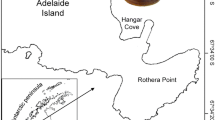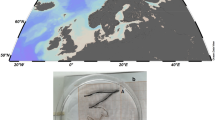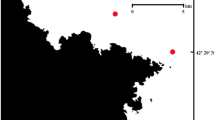Abstract
The large scale-worm Laetmonice producta Grube 1877 is the most abundant aphroditid polychaete in Antarctic coastal waters. We investigated the demographic structure and some reproductive features of different L. producta populations from high-Antarctic (Weddell Sea) and Antarctic Peninsula (King George Island) shelf bottoms, collected in summer 1996 (ANT-XIII/3, EASIZ I cruise) and autumn 2000 (ANT-XVII/3, EASIZ III cruise). L. producta in the studied geographic areas showed a wide bathymetric range (200–850 m depth), and a different size distribution pattern with depth, characterised by a reduction of large specimens in the deepest stations. The species is gonochoric, with females more abundant in specimens of larger sizes. Eggs at different stages of maturation (ranging from 40 to 320 μm in diameter) were examined in 270 individuals from different stations and size classes. Egg size showed a slightly bimodal trend, with largely overlapping egg cohorts, suggesting a continuous reproduction, and a long-lasting gametogenesis. Significant differences (Kolmogorov-Smirnov test, P<0.05) in egg-size frequency distribution were detected only when data of the two geographic areas were compared (Weddell Sea vs King George Island), and not according to stations within each area, and females' size. The two sets of geographic samples were collected in different seasons and therefore it was not possible to assess if differences observed are due to sampling time or to geographic factors.
Mature spermatozoa were recognisable only in autumn male specimens from King George Island, and showed a rounded nucleus and a short conical acrosome. Occurrence of an endosymbiont polychaete, Veneriserva pygoclava meridionalis (new sub-species of Dorvilleidae), was recorded in the coelomic cavity of 163 specimens of L. producta, 125 of which were from the deepest station of the Weddell Sea (stn. 14, 850 m depth). L. producta females with and without the endosymbiont did not show differences in egg-size distribution.
The reproductive features of L. producta, together with its large size and slow growth, seem typical of a long-living predator species, and uncoupled from the typical summer environmental conditions and the pulsating system of coastal Antarctic waters.




Similar content being viewed by others
References
Arntz WE, Brey T (2001) The expedition ANT XVII/3 (EASIZ-III) of R/V "Polarstern" in 2000. Ber Polarforsch 402:1–150
Arntz WE, Gorny M (1991) Shrimp (Decapoda, Natantia) occurrence and distribution in the eastern Weddell Sea, Antarctica. Polar Biol 11:169–177
Arntz WE, Gutt J (1997) The expedition ANT XIII/3 (EASIZ-I) of R/V "Polarstern" to the eastern Weddell Sea in 1996. Ber Polarforsch 249:1–148
Arntz WE, Brey T, Gallardo VA (1994) Antarctic zoobenthos. Oceanogr Mar Biol Annu Rev 32:241–304
Arntz WE, Gutt J, Klages M (1997) Antarctic marine biodiversity, an overview. In: Battaglia B, Valencia J, Walton DWH (eds) Antarctic communities: species, structure, and survival. Cambridge University Press, Cambridge, pp 3–14
Brey T, Clarke A (1993) Population dynamics of marine benthic invertebrates in Antarctic and subantarctic environments: are there unique adaptations? Antarct Sci 5:253–266
Brey T, Dahm C, Gorny M, Klages M, Stiller M, Arntz WE (1996) Do Antarctic benthic invertebrates show an extended level of eurybathy? Antarct Sci 8:3–6
Clarke A (1988) Seasonality in the Antarctic marine environment. Comp Biochem Physiol 90B:461–473
Clarke A, Hopkins CCE, Nilssen EM (1991) Egg size and reproductive output in the deep-water prawn Pandalus borealis Kroyer, 1838. Funct Ecol 5:724–730
Gambi MC (1997) Autoecology of Aphroditidae and Polynoidae (Polychaeta) on the continental shelf and slope of the eastern Weddell Sea. In: Arntz WE, Gutt J (eds) The Expedition ANT XIII/3 (EASIZ I) of R/V "Polarstern" to the eastern Weddell Sea in 1996. AWI, Bremerhaven. Ber Polarforsch 249:66–73
Gambi MC, Giangrande A, Patti FP (2000) Comparative observations on reproductive biology of four species of Perkinsiana (Polychaeta, Sabellidae). Bull Mar Sci 67:299–309
Gambi MC, Patti FP, Micaletto G, Giangrande A (2001) Diversity of reproductive features in some Antarctic polynoid and sabellid polychaetes, with description of Demonax polarsterni n. sp. (Polychaeta, Sabellidae). Polar Biol 24:883–891
Giangrande A (1997) Polychaete reproductive patterns, life cycles and life histories: an overview. Oceanogr Mar Biol Annu Rev 35:323–386
Gorny M, Arntz WE, Clarke A, Gore DJ (1992) Reproductive biology of caridean decapods from the Weddell Sea. Polar Biol 12:111–120
Hartman O (1978) Polychaeta from the Weddell Sea quadrant, Antarctica. Biology of the Antarctic Seas. VI. Antarct Res Ser 26:125–223
Hartmann-Schoeder G, Rosenfeldt P (1992) Die polychaeten der "Polarstern"-Reise ANT-V/1 in die Antarktis 1986. 1. Euphrosinidae bis Iphitimidae. Mitt Hamb Zool Mus Inst 89:85–124
Hutchings P, McRae J (1993) The Aphroditidae (Polychaeta) from Australia, together with the redescription of the Aphroditidae collected during the Siboga expedition. Rec Aust Mus 45:279–363
Klages M (1993) Distribution, reproduction and population dynamics of the Antarctic gammaridean amphipod Eusirus perdentatus Chevreux, 1912 (Crustacea). Antarct Sci 5:349–359
Martin D, Britayev TA (1998) Symbiotic polychaetes: review of known species. Oceanogr Mar Biol Annu Rev 36:217–340
Micaletto G, Gambi MC, Cantone G (2002) A new record of the endosymbiont polychaete Veneriserva (Dorvilleidae), with description of a new sub-species, and relationships with its host Laetmonice producta (Polychaeta: Aphroditidae) in Southern Ocean waters (Antarctica). Mar Biol 141:691–698
Orejas Saco del Valle C, López González PJ, Gili JM, Teixidó N, Gutt J, Arntz WE (2002) Distribution and reproductive ecology of the Antarctic octocoral Ainigmaptilon antarcticum in the Weddell Sea. Mar Ecol Prog Ser 231:101–114
Pearse JS, McClintock JB, Bosch I (1991) Reproduction of Antarctic benthic marine invertebrates: tempos, modes, and timing. Am Zool 31:65–80
Piraino S, Montiel-San Martin A (2001) Autumn diversity and reproductive biology of polychaetes. In: Arntz WE, Brey T (eds) The Expedition ANT XVII/3 (EASIZ III) of R/V "Polarstern" in the eastern Weddell Sea in 2000. Ber Polarforsch 402:98–103
Plyuscheva MV, Britayev TA, Buyanovsky AI (2001) The population structure and seasonal dynamics of Lepidonotus squamatus (Polychaeta: Polynoidae) in the White Sea. Proceedings 7th International Polychaete Conference, Reykjavik (Iceland) 2–6 July 2001 (abstract)
Rossi MM (1984) A new genus and species of iphitimid parasitic in an aphroditid (Polychaeta), with the emendation of the family Iphitimidae. Bull South Calif Acad Sci 83:163–166
Rouse GW (1999) Polychaete sperm: phylogenetic and functional consideration. Hydrobiologia 402:215–224
San Martin G, Parapar J (1997) "Errant" polychaetes of the Livingston island shelf (South Shetland, Antarctica), with the description of a new species. Polar Biol 17:285–292
Stiller M (1996) Distribution and biology of the aphroditids and polynoids (Polychaeta) in the eastern Weddell Sea and the Lazarev Sea (Antarctica). Ber Polarforsch 185:1–200 (in german)
Thorson G (1950) Reproductive larval ecology of marine bottom invertebrates. Biol Rev 25:1–45
Voß J (1988) Zoogeographie und Gemeinschaftsanalyse des Makrozoobenthos des Weddellmeeres (Antarktis). Ber Polarforsch 45:1–145
Acknowledgements
This research was funded by the Italian National Programme for Researches in Antarctica (PNRA). Organisation and logistic support on board R/V "Polarstern" was provided by the Alfred Wegener Institute (A.W.I., Germany). Thanks are due to Professor Arntz WE (A.W.I.), leader of EASIZ cruises, for his warm hospitality and valuable scientific discussions. SEM micrographs were made at the Stazione Zoologica "A. Dohrn" of Naples. Dr. G. Sabatella helped in the worm's dissection and preliminary analysis of symbiont occurrence. Three anonymous referees made useful suggestions and criticism.
Author information
Authors and Affiliations
Corresponding author
Rights and permissions
About this article
Cite this article
Micaletto, G., Gambi, M.C. & Piraino, S. Observations on population structure and reproductive features of Laetmonice producta Grube (Polychaeta, Aphroditidae) in Antarctic waters. Polar Biol 26, 327–333 (2003). https://doi.org/10.1007/s00300-003-0482-3
Received:
Accepted:
Published:
Issue Date:
DOI: https://doi.org/10.1007/s00300-003-0482-3




